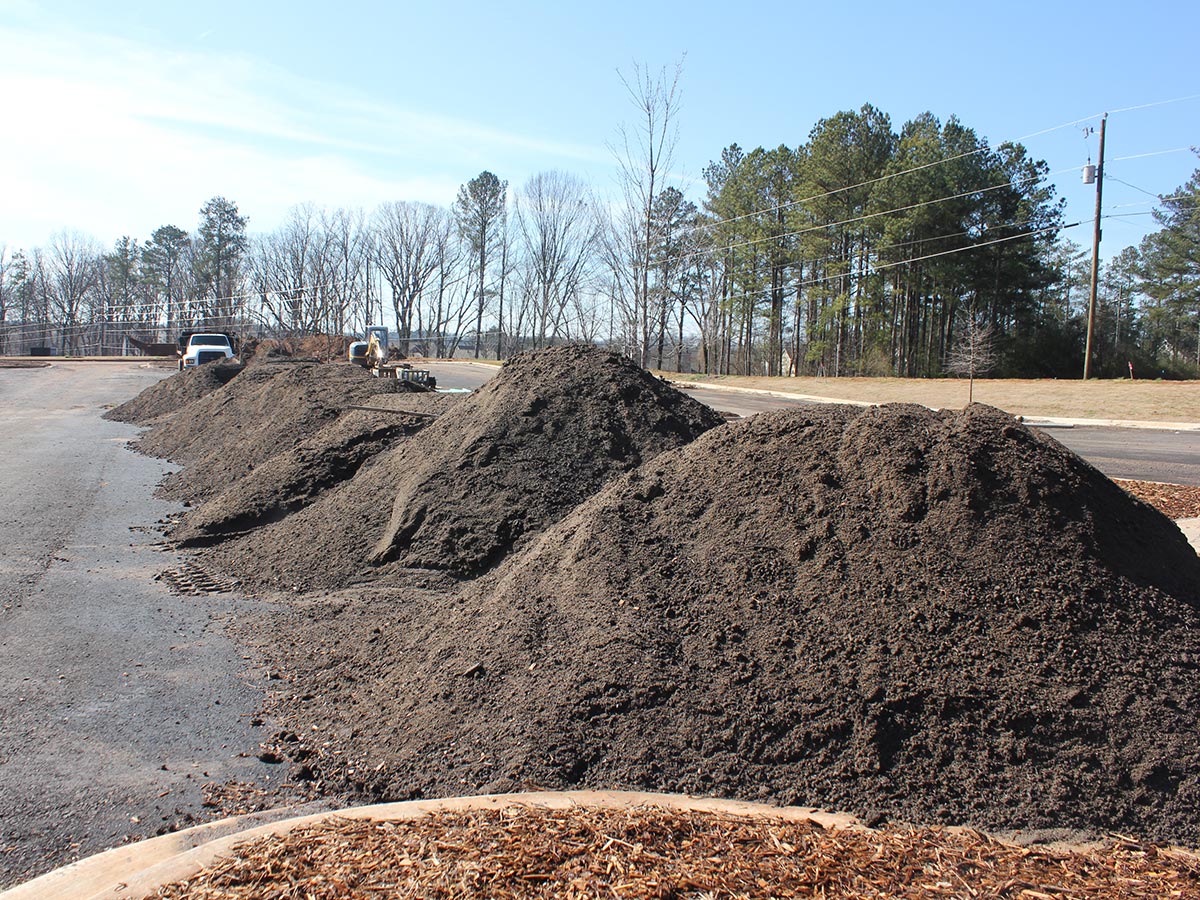
Bioretention Soil Mix
Bioretention Soil Mix
Bio-retention Soil Mix, Bioretention Media, Bioswale Bio Swale, Biosoil, Bio-pond soil, Biomix Soil, Bio-mix, Planting Media, Planting Mix, Engineered Topsoil, Engineered Soil, Bioslope, Dry Well, Infiltration Trench, Sand Filter, Organic Filter, Regenerative Stormwater Conveyance, Stormwater Planters and Tree Boxes
Applications
Bioretention Ponds, Bio-Ponds, Rain Gardens, Stormwater Management, Wetland Planting Media, Retention Pond, Bioswale, Bioretention Basin, Bioretention Area
Key Benefits
Stormwater filtration and management, Improves water quality, Promotes healthy plant growth for nutrient update; Ideal infiltration rate; Reduces erosion; Environmentally beneficial practice for managing storm water and planting media for wetland species; Decreases compaction issues; Removes pollutants; Retains water and nutrients for plants and evapotranspiration
Specs
Blended to meet any infiltration rate (saturated hydraulic conductivity, kSat) or percolation rate, Ideal organic matter content; High CEC (cation exchange capacity); Loamy Sand to Sandy loam (unless otherwise specified); Neutral to slightly acidic pH for native plant species; All-natural soil with no chemicals or pesticides added; Adjusted P-Index
Bioretention Soil Mix
RSI is Atlanta’s bioretention soil supplier. Contractor’s throughout Georgia can expect the best quality bio-soil mix for their project’s planting media mix for bioretention areas, bioponds, rain gardens, or any other stormwater management system requiring engineered topsoil or sand. River Sand, Inc. has a long history of supplying engineered soils, specifically bioretention soil, to projects implementing stormwater systems such as bioretention areas and bioswales to capture and treat runoff. RSI not only provides the bioretention soil, we provide confidence. RSI starts with any project’s specifications that may include infiltration, pH, soil texture, p-index, nutrient level, CEC, organic matter content, clay content, or specific soil mix designs. If your project does not have specifications we can provide a soil that meets the design criteria according to the Georgia Stormwater Management Manual. Next, RSI can provide you with a cut sheet with the specs or mix design and any laboratory analysis required. We utilize our own in-house soil laboratory as well as third-party soil labs. RSI then blends and stockpiles your soil before delivery. We can work with your dump trucks or we will send our fleet of trucks to make certain your soil arrives on time and within schedule. Often installation of biorentention soil must be timed out between rainfall events to eliminate possible contamination before installation on your project. Most importantly RSI provides support to answer any technical questions related to the soil from both inspectors and engineers. We know our soil and are happy to provide guidance to you the client in any aspect.
What is a Bioretention Area? What is the purpose of a Bioretention Area?
A bioretention areas or bioretention basins are shallow landscaped depressions designed to capture and treat stormwater runoff with the use of soil, plants, and microbes. The Georgia Stormwater Management Manual provided and supported by the Atlanta Regional Commission (comprised of Cherokee, Clayton, Cobb, Dekalb, Douglas, Fayette, Fulton, Gwinnett, Henry, Rockdale, and the city of Atlanta) standard focusses on reducing and treating the first 1.2” of rainfall and subsequent runoff from sites which represent 85% of the rainfall in Georgia. Bioretention areas are the low-lying areas engineered to capture this runoff from areas less than 5 acres such as parking lots, roofs, driveways, and other impervious surfaces and allow the runoff to infiltrate through the soil to allow for a reduction in the runoff leaving the site and an improvement in the water quality. They provide a natural, aesthetically appealing look that reduces total suspended solids (TSS), nutrients (Phosphorus, Nitrogen), soluble salts (SS), metals, and pathogens (fecal) from stormwater runoff.
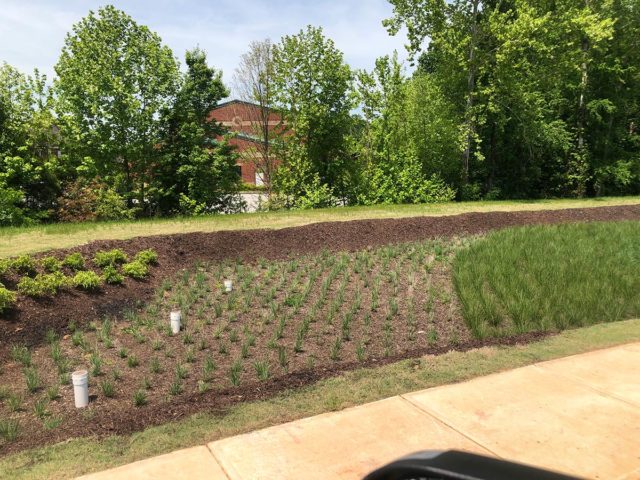
What is Bioretention Soil Mix? What are Bioretention Soil Mix Specifications?
Bioretention Soil Mix is primarily composed of a mixture of sand, soil, compost, and occasionally other amendments such as lightweight expanded clay aggregates (LECA). Each component of sand, soil, and compost can vary greatly in physical and chemical characteristics, so not all sand, soil, or composts are suitable to mix for bioretention areas. The most common confusion with bio-soil mix is the difference in a mix design and soil texture percentages. The mix design is the specification that calls for a certain percentage of each component to be blended. Soil texture is not the same but instead refers to the amount of sand, silt, and clay within the blended mix. Soil texture cannot contain a percentage of compost for example. Soil texture is often defined as loamy sand or sandy loam in these mixes. Sand is commonly the highest percentage of the mix, usually ranging from 70-90%. Not all sand is the same though, as there are manufactured sands and masonry sands for example that will not work within certain mix designs. The sand used in our blends is a natural, silica sand with a specific gradation to allow for infiltration. The soil component is typically a screened soil, free of any contaminants, with the appropriate pH and chemical characteristics to help meet the specs.
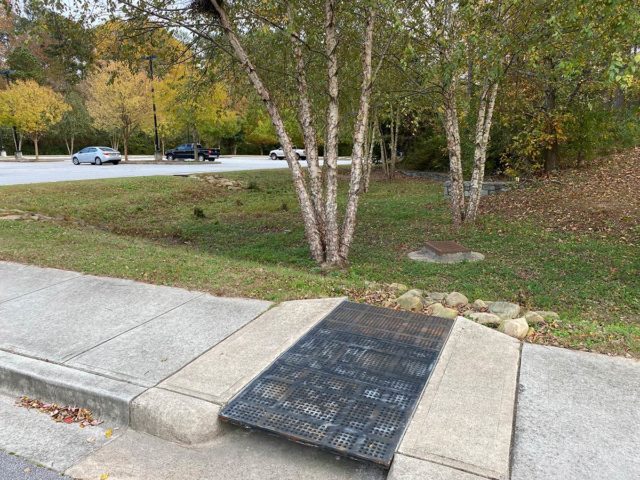
High clay content within the soil is one of the most common factors that eliminates most soils from being utilized in a blend, and even soils that are not “Georgia red clay” may contain clay that leads to failure of the bioretention area. Compost is a much-needed component, usually 5-20% of blends, that stabilizes the pH, promotes beneficial microbial activity, and most importantly adds organic matter content to the planting media mix. Quality compost, not just something that is black and decomposed, is a critical portion of meeting the specs for the engineered soil blend. Other amendments such as lightweight expanded clay (Hydrocks®, Stalite®), hydrogels, perlite, vermiculite, Profile® or Turface® are designed to aid in the water retention capability of the soil for both saturated soil and dry soil to keep plant available water in the media. Regardless of the blend design, the soil must be screened to reduce large debris and be homogenously blended. Blending is achieved with the proper equipment that allows the soil to be mixed multiple times. Blending with a loader often leads to uneven blending and unacceptable results. A thoroughly blended bioretention soil allows for the soil to perform as design from the top to the bottom of the bioretention profile. An example of failure would be if the unmixed soil component were to be installed on the top of the surface and water could not infiltrate into the soil beneath. The typical depth of a bioretention area is 36” – 48” with a minimum of 18”. RSI takes the steps necessary to provide you with a consistent, quality soil that you can install with confidence and ease.
Your next question may be: Where is a bioretention soil supplier near me?
If you need bioretention soil mix in Georgia, then RSI can supply you with bulk bio-soil mix. One of our first projects, over a decade ago, involved meeting with county leaders, engineers, and the contractor as they watched the process from start to finish. We still provide opportunities to learn more about the importance of engineered soil design through conversations with engineers and even offer lunch-and-learn opportunities. Here is a list of a few of the locations and examples of projects that required the use of this bioretention areas as a BMP and the contractor purchased bioretention soil mix from RSI:
Atlanta (Airport, Parks, Schools), Athens (Jail and Schools), Gainesville (Stream Remediation), Alpharetta (Car Dealership), Roswell (Various Retailers), Lilburn (Various Retail Stores), Lawrenceville (Municipal Complex), Cumming (Multiple Schools), Dawsonville (Commercial Building), Clarkesville (Parking Lots), Cornelia (Airport), Commerce (Library), Stockbridge (Commercial Project), Jonesboro (Healthcare Facility), Milton (Corporate Campus), Norcross (Industrial Develelopment), Canton (Gas station)
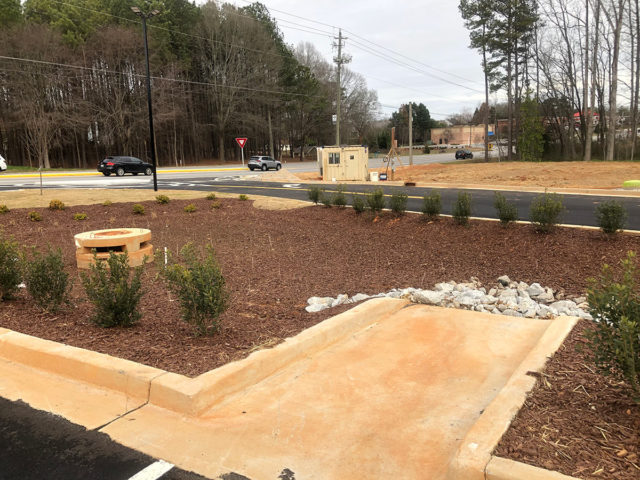
What is the cost of bioretention soil media? What is the price per ton or per cubic yard of bioretention soil planting mix?
The cost of bioretention soil mix is varies depending on a few factors. The primary factor determining cost of the engineered soil media is the mix design, including the components of available bulk sand, soil, compost, and other materials. Sand cost ranges from $8 to $30 per ton on average. The lower cost sand from sources in Georgia is often not suitable for use in bioretention soil. Topsoil cost have an even greater range in price but quality soils with limited clay content are difficult to source and even more difficult to determine consistency. Compost like the sand and soil need to be sourced based on quality. Mature compost is not just manure that someone needs to get off the farm, rather is it one that has reached the temperature and been turned appropriately to achieve the correct pH, organic matter content, and full of beneficial microbes. Therefore, the cost is typically $10 to $30 per cubic yard. Other amendments vary greatly in cost and can be up to 10X the cost per unit from the base of sand, soil, and compost. RSI produces our own components at our various facilities throughout Georgia to minimize the cost and guarantee the quality. Amendments are sourced from reputable companies with a quality control and assurance program. Consistent lab testing of the components further assures quality but is a considerable cost factor itself.
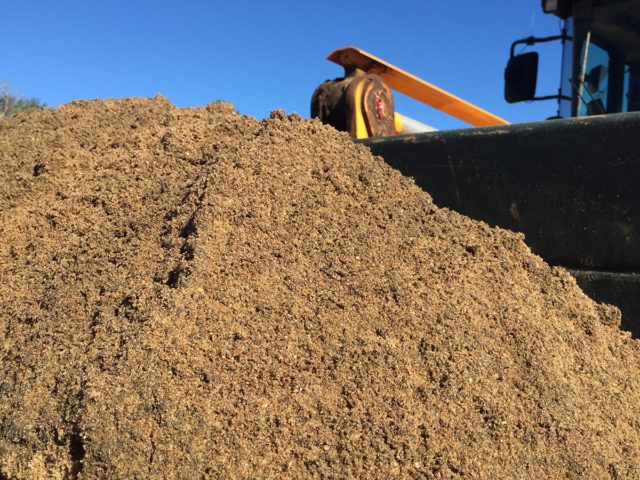
Blending the soil requires handling the material several more times which is the final factor with labor and equipment. Most of our bioretention soils are blended per the specifications and on-demand. One other advantage we offer is the multiple locations that help lower our carbon footprint with delivery, and most importantly the cost of trucking to the project site. Contractors must consider the cost that comes with sourcing their material from RSI. We have experienced many projects with other suppliers or using native on-site soil that failed and the cost to replace a bioretention area once completed and landscaped was much more than any of the original cost involved. Give us a call with your specs, or we can provide a soil to spec, for an accurate quote of the bioretention soil cost!
We Deliver!
River Sand, Inc. is your bulk landscaping supply yard and source for construction materials including sand, soil, and gravel. Call today for the cost and to schedule delivery for your bioretention soil mix.
Frequently Asked Questions
Do you have questions about Bioretention Soil Mix? We have answers!
Bioretention soil mix or biosoil is a soil designed to be placed in a bioretention cell. It is blended to meet certain criteria such as pH, infiltration, texture, P-index, nutrients, soluble salts, and organic matter content. The engineer, architect, or best management practice guidelines may change for each project. The bioretention soil’s function is to treat stormwater runoff effectively. The blend much be homogenous to make sure there are no inconsistent portions of the soil that cause the whole bioretention system to fail.
Bioretention soil mix, or Bio Soil, is an engineered soil that is designed to be placed in bioretention areas that capture, retain, and treat stormwater runoff. These areas are typically placed beside impervious surfaces such as buildings, parking lots, or roads so the runoff can be directed into the cell. Rip rap or concrete flumes help dissipate the velocity of the runoff and a thin mulch layer on top along with specific plants are on the surface of the cell on top of the bioretention soil mix. The bioretention soil is designed to have a specific range of infiltration for the water to move through the soil. The organic material and soil’s ability to update nutrients and other contaminants acts like a filter for the stormwater. The water is allowed to remain in the cell for uptake by the plants, infiltrate into the groundwater, or filtered before discharge. The soil must meet certain criteria for physical and chemical characteristics like pH, infiltration, texture, P-index, nutrients, soluble salts, organic matter, and more.
Bioretention ponds, bioretention cells, and bioretention basins are common names referring the same systems. Rain gardens are usually smaller versions of these systems. The idea is to capture stormwater runoff, specifically the water from smaller, more frequent events. Generally, this water contains the most contaminants of nutrients, oils/grease, and other debris. The bioretention areas are landscaped with plants and contain engineered soil to help filter the runoff and reduce the quantity of the runoff. A bioretention pond is designed to slowly release clean water back into the watershed over a longer period of time that benefits the environment.
Bioretention soil mix typically consists of sand, soil, and compost. Some blends call for the addition of calcined clay products or mulch. The mix can be determined in the plans by ratios of volume or a dry weight basis (which require some conversion). Each component must meet certain specifications in addition to the final blend meeting criteria. RSI uses large stockpiles of each component that has be tested by a soil lab to blend into a soil mix that is completely homogenous for consistency. Each component is measured for an accurate blend. The final bioretention soil mix is tested to make sure it meets the criteria for the project. The blended soil can be delivered and placed into the cell or basin without contaminating it. Mixing soil on-site can be a tedious process and limited to available soil that may not be suitable. The worst-case scenario is for a soil to cause a system to fail. RSI has decades of experience to make sure you have a quality bioretention soil mix that you can be confident will work effectively.
There are specific plans with most project outlined by engineers and architects specific to each project’s landscape. However, the general idea is to place a [perforated drainage pipe, usually with a filter sock along the bottom of a small pond dug along that collects the stormwater. The pond is typically 4 to 6 feet in depth. The drainage pipe discharges outside of the pond but also has a T or connection for a vertical standpipe that will be above the surface level of the pond for overflow discharge. The underdrain system is typically filled with #57 gravel and lined with a geotextile liner. Above the gravel and drainage system the bioretention soil mix is placed usually 36 to 48 inches in depth and covered with a mulch layer. During the installation process machinery and other equipment must not be used to compact the bioretention soil as it is installed. This can be done with excavators positioned from the edge, slinger trucks, or in a manner that starts in sections and works your way out of the pond. Select native plants are planted within the pond to uptake moisture and nutrients retained. The inlets are lined with concrete or rip rap to prevent incoming runoff from eroding the edges of the pond.
Related Articles
See what we’ve been saying about
Bioretention Soil Mix
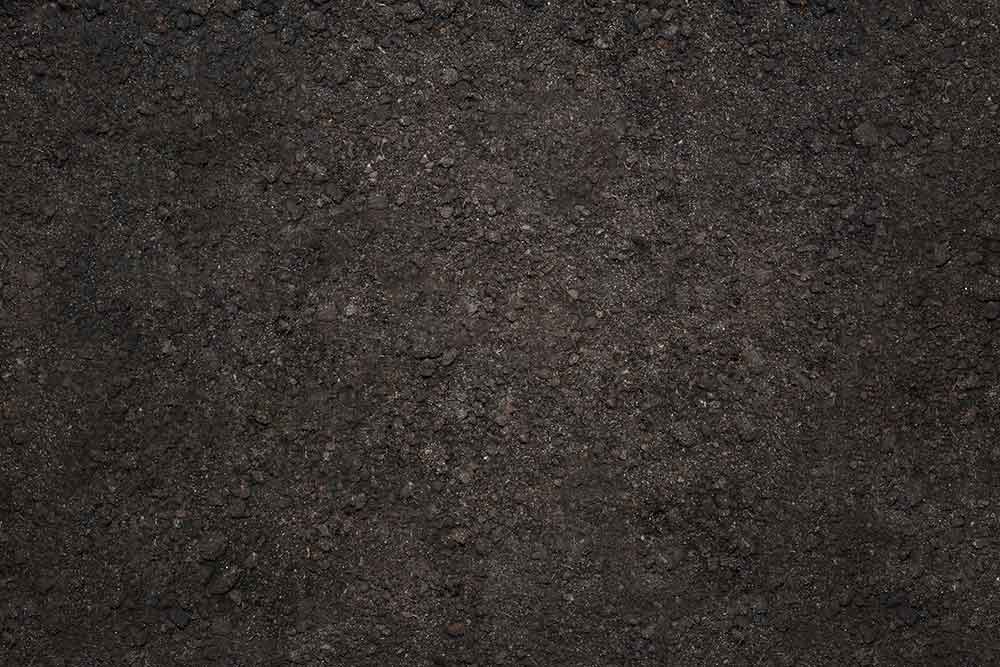
“We have used this company for many years and they have always met our expectations. Their staff is very helpful, their products are what they say they are, and the material is always delivered on time by good drivers.”
— James Laroway
Related Products
Calculate Your Project
Determine how much product you need for your project and submit it to us for a free estimate, including delivery costs.
Dredging projects and In-Field Mix are calculated separately.
